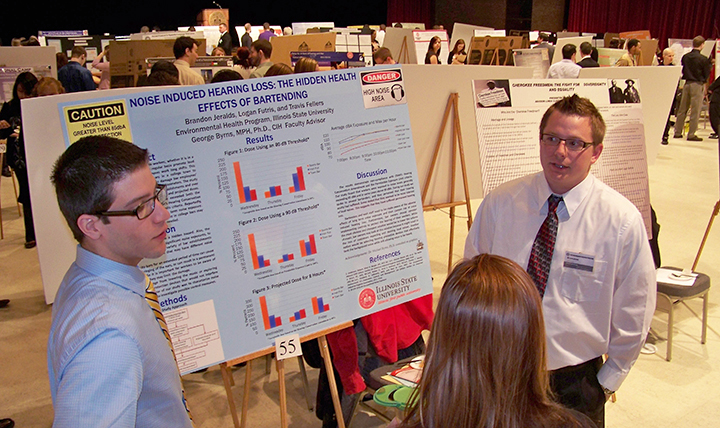Even by college student standards, Brandon Jeralds, Logan Futris, and Travis Fellers spent a lot of time in bars this year. Five hours a night, actually, at three different bars, for three weeks.
But don’t worry: They were doing it all for science. No, really.
The trio, all students in the Department of Health Sciences, were conducting a research project on noise-induced hearing loss. When you go out to a bar, you don’t think about the constantly loud noise, Futris says. Now imagine what a bartender experiences over the course of an eight-hour shift.
“Curiosity is what drove us to do this,” said Futris, a senior environmental health major.
Their work was on display at the recent Undergraduate Research Symposium, an annual event that spotlights the work of 250 students at Bone Student Center. Illinois State is a diverse community of scholars in the business of generating knowledge—and that’s not limited to graduate students or faculty members.
Take the bar-noise project. Noise is a “big, abstract idea” that’s difficult to wrap your head around, and that’s what drives Futris’ interest in it. So Futris and his partners, under the guidance of faculty mentor George Byrns, plotted out a way to measure the ambient noise levels at three bars over three weeks, using two dosimeters, one pinned to a wandering person, the other stationary.
Their results project that, over an eight-hour period, all three bars would have noise levels exceeding a key benchmark that would require the business to provide a hearing protection program to workers.
Their results and methodology were laid out on one of the many posters lining the Brown Ballroom on April 19, running the research gamut from psychology to fashion to mathematics.

History education seniors Kelsey Hoover, right, and Sareh Ricca with their “Normal ISU Slang” research poster.
One of the more eye-catching posters belonged to history education seniors Kelsey Hoover and Sareh Ricca, who built from scratch a comprehensive, 30-page dictionary of Illinois State-related slang. Wondering what exactly is Hewman, or PDS, or Club Milner? Their dictionary has the answers.
The idea started with their history professor, Agbenyega Adedze, who gave Hoover and Ricca an opportunity to do a historical linguistics project. Inspired by a popular slang dictionary at the University of California Los Angeles, Hoover and Ricca got to work, conducting email surveys; interviewing students, faculty, and staff; stopping random people in the hallway; and even asking family members who are alumni.
They sought confirmation on definitions from multiple sources, and even researched the etymology of certain words, like “townie.” One of their favorites was “swoll factory,” defined as “the second floor of the Student Fitness Center where only men work out,” or to get their muscles “swollen.”
The students are now looking for somewhere to display the dictionary permanently.
“It would be cool to see it live on,” said Hoover.
Organizers of the two-hour symposium give students displaying their research 20 minutes to wander around to other posters and conduct peer review. All participants can also get reviews of their research through feedback forms. (A similar symposium for graduate research was held April 5.)
The undergraduate symposium, now in its 23rd year, is important because it exposes students to research early on, said Kim Shennett, symposium coordinator and Illinois State’s coordinator of Graduate Faculty Services. They might also choose to continue their research in the future.
“They get motivated by it, encouraged by it,” Shennett told STATEside. “This may be something they didn’t know they liked to do.”
Each student is paired with a faculty mentor. Junior biochemistry major Shawn Sternisha got to work with two mentors, but that was one of the reasons he chose his research topic.
Sternisha is studying Leishmania, a deadly parasite that causes Leishmaniasis, the second-leading parasitic protozoan killer in the world, primarily in tropical and subtropical regions. There are not many good treatments that can counteract the parasite, said Department of Chemistry professor Marjorie Jones, one of Sternisha’s mentors, along with associate professor David Cedeño.
“So we wanted to understand some of the biochemistry, the things that Leishmania does that we can target for drug therapy,” Jones told STATEside.
Sternisha, who is looking at ways to negatively affect Leishmania cells, already presented his research at the 245th annual American Chemical Society national meeting and exposition in New Orleans earlier this month. That trip, and opportunities like the undergraduate symposium, mean a lot to him.
“If you’re dedicated and determined, you can do great things,” he said.
Ryan Denham can be reached at rmdenha@IllinoisState.edu.


